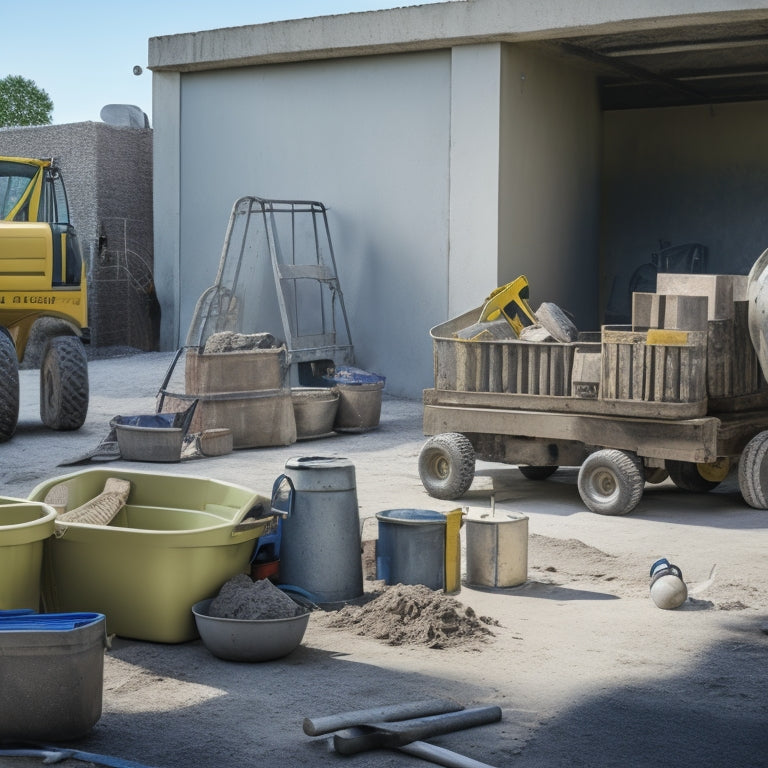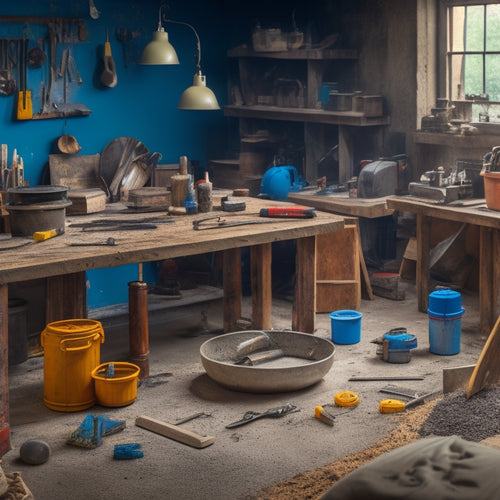
Essential Tools for Concrete Block Contractors
Share
As a concrete block contractor, you need a range of essential tools to get the job done efficiently and effectively. You'll require concrete block cutting tools like a block saw, durable blade guard, and masonry blades for smooth, accurate cuts. Block splitting tools, such as a block splitter and mason's chisel, are also vital for fast and precise splitting. Don't forget essential drilling equipment, safety gear, measuring and marking tools, and specialized hand tools for finishing. By having these tools in your arsenal, you'll be well-equipped to tackle complex concrete block projects and achieve a professional finish - and that's just the foundation of what you'll need to know to take your work to the next level.
Key Takeaways
• Concrete block cutting tools, such as block saws and masonry blades, are essential for making accurate cuts and achieving a professional finish.
• Block splitting tools, including block splitters and mason's chisels, help reduce manual labor and ensure precise splitting along score lines.
• Drilling equipment, like rotary hammers and drill bits, must be selected and maintained properly to minimize tool wear and increase productivity.
• Safety gear, including hard hats, safety glasses, and dust masks, is crucial for protecting concrete block contractors from job site hazards.
• Measuring and marking tools, such as laser levels and combination squares, ensure accurate layouts and precise cuts, maintaining structural integrity and quality.
Must-Have Concrete Block Cutting Tools
You'll need a reliable concrete block cutting tool to accurately split blocks to fit around corners, doors, and windows, and to make precise cuts for a professional-looking finish. For precision cutting, consider investing in a block saw, which is specifically designed for cutting concrete blocks. These saws typically feature a diamond-coated blade that can withstand the abrasive nature of concrete, allowing for smooth, accurate cuts.
When choosing a block saw, look for one with a robust motor and a durable blade guard to guarantee safe operation.
Additionally, consider the type of masonry blades you'll need, as they come in various sizes and types. A high-quality masonry blade is essential for making clean, precise cuts in concrete blocks. Look for blades with a diamond-coated edge and a durable core to withstand the rigors of cutting through concrete.
With the right block saw and masonry blades, you'll be able to make precise cuts with ease, guaranteeing a professional-looking finish for your concrete block projects.
Essential Drilling Equipment for Contractors
When it comes to drilling into concrete blocks, you need the right equipment to get the job done efficiently and effectively.
You'll want to select the appropriate drill bits for the task at hand, considering factors like diameter, material, and coating.
Next, you'll need to know how to operate a rotary hammer safely and correctly to guarantee precise drilling and minimize wear on your tools.
Drill Bit Selection
Selecting the right drill bit is essential to achieving accurate holes and reducing wear on your equipment, as the wrong choice can lead to premature bit failure and decreased productivity. As a contractor, you know that drilling into concrete blocks requires the right tools for the job. When it comes to drill bits, you have several options to choose from.
Here's a quick guide to help you make the right selection:
| Drill Bit Type | Drill Bit Material |
|---|---|
| Twist bits | High-speed steel (HSS) or tungsten carbide (TC) |
| Masonry bits | Carbide-tipped or diamond-coated |
| Core bits | Diamond-coated or carbide-tipped |
| Step bits | High-speed steel (HSS) or tungsten carbide (TC) |
When choosing a drill bit, consider the type of concrete block you're working with, as well as the specific task at hand. For example, twist bits are great for general-purpose drilling, while masonry bits are better suited for drilling into hard, abrasive materials. By selecting the right drill bit type and material, you'll be able to achieve accurate holes, reduce wear on your equipment, and increase your overall productivity.
Rotary Hammer Operation
With the right drill bit in hand, it's time to focus on the equipment that'll help you get the job done efficiently - your rotary hammer. As a concrete block contractor, you know how vital it is to operate your rotary hammer safely and effectively.
Here are some key tips to keep in mind:
Rotary Hammer Operation Essentials
-
Regular Maintenance: Perform routine checks on your rotary hammer to guarantee it's in good working condition. Check for wear and tear on the cord, switches, and other moving parts. Regular maintenance will help prevent breakdowns and reduce downtime.
-
Proper Grip: Hold the rotary hammer with a firm, but not overly tight, grip. This will help you maintain control and reduce fatigue.
-
Correct Technique: Use a steady, controlled motion when drilling. Apply gentle to moderate pressure, depending on the material you're working with.
- Safety First: Always wear protective gear, including safety glasses, gloves, and a dust mask. Make sure you're aware of your surroundings and keep bystanders at a safe distance.
Block Splitting Tools for Efficiency
You'll need the right block splitting tools to efficiently cut and shape concrete blocks to fit your project's unique requirements. Mastering block splitting techniques is vital for efficient block handling, and the right tools can make all the difference. Here are some essential tools to have in your arsenal:
| Tool | Description | Benefits |
|---|---|---|
| Block splitter | Hydraulic or pneumatic tool that splits blocks into desired sizes | Fast and accurate splitting, reduced manual labor |
| Mason's chisel | Handheld tool for splitting and shaping blocks | Precise control, ideal for intricate cuts |
| Block saw | Circular saw designed for cutting concrete blocks | Clean cuts, reduced dust and debris |
| Splitting wedges | Wedge-shaped tools used to split blocks along score lines | Controlled splitting, reduced risk of breakage |
| Safety clamps | Devices that hold blocks in place during splitting | Prevents blocks from shifting or breaking, improved safety |
Safety Gear for Concrete Block Work
Frequently, concrete block contractors overlook the significance of safety gear, but it's vital to wear the right protective equipment to prevent injuries and guarantee a successful project.
As you work with concrete blocks, you're exposed to various hazards, from falling objects to harsh chemicals. That's why investing in personal protective equipment (PPE) and ensuring site safety is important.
Here are the top safety essentials you should have:
-
Hard Hat: A must-have for any construction site, hard hats protect your head from falling objects and debris.
-
Steel-Toed Boots: These boots protect your feet from heavy objects and tools that may fall or slip.
-
Safety Glasses: Safety glasses or goggles shield your eyes from flying particles, dust, and chemical splashes.
- Dust Mask: A dust mask or respirator filters out harmful particles and dust, preventing respiratory issues.
Measuring and Marking Tools Required
When you're working with concrete blocks, accuracy is key.
You'll need to make certain your blocks are level, plumb, and properly aligned, which is where measuring and marking tools come in.
You'll be using tools like levels, straight edges, squares, chalk lines, and snaps to guarantee precision and avoid costly mistakes.
Level and Plumb Tools
Accurate leveling and plumbing are critical to building structurally sound concrete block walls, which is why having reliable level and plumb tools is essential to guaranteeing a successful project. You need to guarantee that your walls are perfectly level and plumb to prevent structural issues and costly rework.
Here are the essential level and plumb tools you should have in your toolbox:
-
Laser levels: These tools project a level line or dot onto a surface, allowing you to quickly check the levelness of your walls.
-
Plumb bob: A plumb bob is a weight attached to a string that guarantees your walls are perfectly vertical.
-
Digital level: A digital level provides precise level and plumb readings, often with more accuracy than traditional bubble levels.
- Toric level: A toric level is a specialized level designed for checking the levelness of curved surfaces, such as arches or columns.
Straight Edge and Square
You'll need a combination of straight edge and square tools to guarantee precise measurements and markings on your concrete block walls. These tools are essential for validating that your blocks are laid level, plumb, and square, which is critical for the structural integrity of the wall.
Here are some key straight edge and square tools you'll need:
| Tool | Description | Application |
|---|---|---|
| Straight Edge | A long, rigid ruler used to draw straight lines and check for straightness | Used to draw lines, check for straightness, and validate accurate block placement |
| Try Square | A precision square used to check for square accuracy | Used to validate square accuracy in corners and intersections |
| Combination Square | A multi-purpose square used for measuring, marking, and checking square accuracy | Used for measuring, marking, and checking square accuracy in various applications |
| Laser Square | A high-tech square used to project precise lines and squares | Used to project precise lines and squares for large-scale projects and complex layouts |
Chalk Lines and Snaps
With your concrete block walls' layout and squareness assured, it's time to focus on measuring and marking the blocks themselves, and that's where chalk lines and snaps come into play. These essential tools help you accurately mark cutting lines, layout patterns, and identify block locations.
To get the most out of your chalk lines and snaps, you'll need to master some key techniques.
Here are some best practices to keep in mind:
-
Choose the right chalk: Select a high-quality chalk that produces a vibrant, consistent line. Experiment with different colors to find what works best for your specific project.
-
Maintain your snap lines: Regularly clean and dry your snap lines to prevent rust and guarantee accurate measurements.
-
Use chalk line techniques effectively: Learn various chalk line techniques, such as 'snapping' lines for precise layouts and 'scribing' lines for curved cuts.
- Store your tools properly: Keep your chalk lines and snaps organized and protected in a designated toolbox or storage area to prolong their lifespan.
Specialized Hand Tools for Finishing
By incorporating specialized hand tools into your finishing process, you can achieve a professional-looking finish and avoid costly rework. These tools are designed to help you master various trowel techniques and finishing methods, allowing you to deliver high-quality results efficiently.
Here are some essential specialized hand tools for finishing:
| Tool | Description |
|---|---|
| Edger | Used to create clean edges and joints, ensuring a seamless finish. |
| Jointer | Helps to fill and finish joints, creating a uniform appearance. |
| Finishing Trowel | Designed for final finishing stages, providing a smooth, even surface. |
| Float | Used to level and smooth out freshly poured concrete, preparing it for finishing. |
| Darby | A long, flat tool used to level and smooth large areas of concrete. |
Frequently Asked Questions
What Is the Best Way to Store Concrete Block Tools on a Job Site?
When storing concrete block tools on a job site, you'll want to prioritize tool organization and invest in sturdy storage solutions.
Consider using a portable toolbox or chest with dividers to keep tools categorized and easily accessible. Label each compartment to guarantee you and your team can quickly find what you need.
Additionally, utilize vertical storage options like pegboards or hooks to maximize space and keep frequently used tools within reach.
How Often Should I Sharpen My Concrete Block Cutting Saw Blades?
Like a chef sharpening their knife, you should regularly hone your concrete block cutting saw blades to maintain a razor-sharp edge.
Aim to sharpen them every 1-3 months, depending on usage and cutting techniques.
Proper blade maintenance is key to efficient cutting and extending the lifespan of your blades.
Keep a log to track your sharpening schedule, and you'll be slicing through blocks like butter in no time.
Can I Use a Hammer Drill for Concrete Block Drilling Tasks?
When drilling into concrete blocks, you'll want to contemplate the right tool for the job.
While a hammer drill can be tempting, its features aren't ideal for concrete block applications. You'll likely struggle with slow penetration and increased wear on the drill.
Instead, opt for a rotary hammer or SDS drill designed specifically for masonry work. These tools are built for the task, providing faster drilling and reduced maintenance.
What Is the Recommended Frequency for Cleaning Concrete Block Tools?
When you're working with concrete block tools, regular cleaning is essential to maintain their effectiveness. You should clean your tools daily, or after every use, to prevent concrete residue buildup.
Develop a tool maintenance routine that includes wire brushing, oiling, and storing tools in a dry place. Mastering these cleaning techniques will extend the lifespan of your tools and guarantee peak performance on the job site.
Are There Any Specific Regulations for Concrete Block Disposal on Site?
Congratulations, you've managed to create a mountain of concrete waste on your construction site!
Now, let's get serious. You're probably wondering if there are any specific regulations for concrete block disposal on site. The answer is, yes!
You must comply with local disposal regulations to minimize environmental impact.
Make sure to segregate and dispose of concrete waste properly to avoid hefty fines and a damaged reputation.
Conclusion
As you wrap up your concrete block project, you can pat yourself on the back - but only if you've got the right tools in your arsenal.
Think of your toolkit as a well-oiled machine, humming along smoothly with each cut, drill, and split.
Without these essential tools, you're just spinning your wheels.
Invest in the must-haves, and you'll be building like a pro in no time.
Related Posts
-

Top Tools for Mixing Concrete at Home
When mixing concrete at home, you'll need a range of tools to guarantee a successful operation. Start with essential ...
-

Budget-Friendly Tools for DIY Decorative Concrete Profiling
You can achieve professional-grade decorative concrete results on a budget by investing in the right combination of e...
-

10 Best Tools for Sealed Concrete Finishing Success
When it comes to sealed concrete finishing success, you need a robust arsenal of specialized tools. Start with essent...


